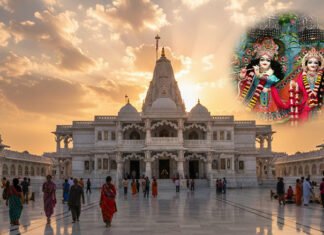Introduction
India is home to a remarkable collection of UNESCO (United Nations Educational, Scientific and Cultural Organization) World Heritage Sites, top 10 UNESCO Indian heritage sites, each showcasing the country’s rich cultural and natural heritage. As of 2024, India boasts 42 UNESCO-recognized sites, with Santiniketan and the Hoysala Temples being the latest additions. This guide provides complete details, including history, significance, timings, and the best time to visit each site.
Newest UNESCO World Heritage Sites (2024)
1. Santiniketan
History:
Rabindranath Tagore established Santiniketan with the idea of blending nature, spirituality, and education. The university and its surrounding areas became a center for arts and culture, attracting artists, writers, and intellectuals from across the world.

Significance:
Santiniketan holds immense cultural and historical importance as the birthplace of Visva-Bharati University, a hub of creativity and intellectual exchange. It is also the site where Tagore wrote many of his works. The place is a symbol of his philosophy of education, peace, and unity across cultures.
Timings:
Santiniketan is open to visitors throughout the year, and there are no fixed opening hours for the town itself. However, the museums and university buildings generally follow the timings of 10:00 AM to 5:00 PM, Monday to Saturday.
Location:
Santiniketan, Bolpur, West Bengal 731235, around 160 km north of Kolkata.

“Click on the map to begin your journey.”
Best Time to Visit:
The ideal time to visit Santiniketan is from October to Octoberwhen the weather is pleasant and perfect for exploring the campus and nearby areas. The winter months also host many cultural festivals, including Poush Mela, which showcases local arts, crafts, and performances, making it a unique experience.
Must check: Ultimate Spiritual Journey Plan to Char Dham (Yamunotri, Gangotri, Kedarnath, Badrinath)
2. Hoysala Temples
History:
The Hoysala dynasty built the Hoysala Temples, ruling parts of Karnataka and Tamil Nadu. Belur’s Chennakeshava Temple, Halebidu’s Hoysaleswara Temple, and Somanathapura’s Keshava Temple are renowned for their intricate sculptures, detailed carvings, and exemplary Dravidian architectural style. The Hoysala dynasty primarily dedicated these temples to Hindu deities like Vishnu and Shiva, and they serve as lasting symbols of the dynasty’s cultural and architectural legacy.

Significance:
People consider the Hoysala temples masterpieces of Indian temple architecture, known for their highly detailed sculptures, pillars, and reliefs that depict scenes from Hindu mythology, daily life, and royal grandeur. The temples at Belur and Halebidu are UNESCO World Heritage nominees due to their historical importance and architectural excellence. The temples are also significant pilgrimage sites, drawing devotees and historians alike.
Timings:
The temples are generally open for visitors from 6:00 AM to 8:00 PM. However, it is advisable to check with the local authorities for any specific changes in timings, especially during festivals or holidays.
Location:
- Chennakesava Temple, Belur:
Belur, Hassan District, Karnataka 573115, India - Hoysaleswara Temple, Halebidu:
Halebidu, Hassan District, Karnataka 573121, India - Keshava Temple, Somanathapura:
Somanathapura, Mysuru District, Karnataka 571126, India
“Click on the Address to begin your journey.”
Best Time to Visit:
The best time to visit the Hoysala temples is between October and March, during the cooler months of the year. The weather is more comfortable for sightseeing, and it the one of the main places in the top 10 UNESCO Indian heritage sites, and region’s scenic beauty is at its best. Additionally, cultural events and festivals, like Mahashivaratri at Halebidu, take place during this time and are celebrated with great fervor.
Also Read: Unveiling the Architectural Splendor of the Chaturmukha Brahma Temple
3. Taj Mahal
History:
Mughal Emperor Shah Jahan built the Taj Mahal in memory of his beloved wife, Mumtaz Mahal, who died during childbirth in 1631. Construction began in 1632 and took over 20 years to complete, with thousands of artisans and laborers working on the monument. The Taj Mahal is made of white marble and is set amidst beautiful gardens and a reflecting pool, representing a blend of Persian, Ottoman Turkish, and Indian architectural styles.

Significance:
The Taj Mahal is considered a masterpiece of Mughal architecture and is recognized globally as a symbol of eternal love. It was designated as a UNESCO World Heritage Site in 1983 due to its cultural and historical significance. The monument attracts millions of visitors annually and is one of the Seven Wonders of the World.
Timings:
The Taj Mahal is open to visitors every day except Friday. The visiting hours are from 6:00 AM to 7:00 PM, with the best time to visit being early morning or late afternoon to avoid the crowd and heat. Night viewing is allowed on full moon nights and for a few days before and after the full moon (with prior booking).
Location:
The Taj Mahal is located in Agra, Uttar Pradesh, India, about 200 km southeast of Delhi.
Agra is well-connected by road, rail, and air to major cities in India.

“Click on the map to begin your journey.”
Best Time to Visit:
The ideal time to visit the Taj Mahal is during the winter months, from October to March, when the weather is cool and pleasant. The monument is particularly beautiful during sunrise and sunset when the light creates a stunning effect on the marble surface.
Also Read: Exclusive of Singarakonda Lakshmi Narasimha Swamy Temple
4. Ajanta Caves
History:
The Ajanta Caves were discovered in 1819 by a British officer and are believed to have been built in two phases: the first between the 2nd century BCE and 1st century CE and the second from the 5th to the 6th century CE. The caves served as a monastic retreat for Buddhist monks and were used for meditation and religious practices. The stunning frescoes and sculptures were created by master artisans, showcasing the rich cultural and religious heritage of ancient India.

Significance:
The Ajanta Caves are a UNESCO World Heritage Site and are renowned for their exquisite murals, which are among the finest examples of ancient Indian art. They provide valuable insights into the history, culture, and religious practices of the time. The paintings inside the caves are especially famous for their depiction of Buddhist stories, daily life, and natural surroundings.
Timings:
The Ajanta Caves are open to visitors daily from 9:00 AM to 5:30 PM. They are closed on Mondays.
Address:
Ajanta Caves, Ajanta, Maharashtra 431001, India
Located approximately 100 km from Aurangabad, Maharashtra.

“Click on the map to begin your journey.”
Best Time to Visit:
The best time to visit Ajanta Caves is during the winter months, from October to March, when the weather is cooler and more pleasant for exploring the caves. Avoid the summer months, as temperatures can get quite high in the region. it the one of the main places in the top 10 UNESCO Indian heritage sites.
Also read: Top 11 Must-Visit Forts in Andhra Pradesh | History, Architecture & Travel Guide
5. Ellora Caves
History:
Ellora Caves were created between the 5th and 10th centuries under the patronage of the Rashtrakuta dynasty and other local rulers. The complex consists of 12 Buddhist caves, 17 Hindu caves, and 5 Jain caves. The caves are carved into the basalt rock of the Sahyadri hills and are known for their stunning architecture and intricate sculptures. The most famous cave is Kailasa Temple (Cave 16), which is a single monolithic structure, carved from top to bottom.

Significance:
Ellora Caves are recognized as a UNESCO World Heritage Site due to their religious, cultural, and architectural significance. The site showcases the coexistence of three major religions and features a blend of Hindu, Buddhist, and Jain art and architecture. The Kailasa Temple, especially, is considered a marvel of rock-cut architecture. The caves are one of the largest religious complexes in the world.
Timings:
Ellora Caves are open to visitors from 9:00 AM to 5:30 PM daily. The site is closed on Mondays.
Address:
Ellora Caves,
Ellora, Aurangabad, Maharashtra 431102, India
Located about 30 km from Aurangabad, Maharashtra.

“Click on the map to begin your journey.”
Best Time to Visit:
The best time to visit Ellora Caves is during the winter months, from October to March, when the weather is cool and pleasant. Avoid visiting during the summer, as the temperatures can soar, making exploration uncomfortable.
Also Read: Penchalakona Lakshmi Narasimha Swamy Temple – A Famous Pilgrimage Site Surrounded by Hills
6. Sundarbans National Park
History:
The Sundarbans, which means “beautiful forests,” have been home to diverse flora and fauna for centuries. The area was declared a National Park in 1984 and later a UNESCO World Heritage Site in 1987. The park is part of the larger Sundarbans Delta, which spans both India and Bangladesh, and it the one of the main places in the top 10 UNESCO Indian heritage sites, and is an important conservation area for endangered species like the Bengal tiger and saltwater crocodile.

Significance:
Sundarbans National Park is a crucial biodiversity hotspot and one of the most ecologically significant areas in India. It is the largest tidal halophytic mangrove forest in the world and provides a unique habitat for wildlife, including tigers, spotted deer, wild boars, and various species of birds and reptiles. The park plays a vital role in protecting the coastal areas from storms and erosion.
Timings:
Sundarbans National Park is open for tourists from 6:00 AM to 6:00 PM. However, it is best to consult local authorities for specific timings, especially during the monsoon season (June to September), when the park may be closed due to weather conditions.
Address:
Sundarbans National Park,
Sundarbans, South 24 Parganas, West Bengal, India
Located approximately 100 km from Kolkata.

“Click on the map to begin your journey.”
Best Time to Visit:
The best time to visit Sundarbans National Park is during the winter months, from November to February, when the weather is cooler and more comfortable for wildlife safaris and boat rides. The summer months (March to May) can be hot and humid, and the monsoon season (June to September) can make the area inaccessible due to heavy rainfall.
Also Read: Ultimate Guide fot Top 10 Must Visit South Indian Temples
7. Khangchendzonga National Park
History:
Khangchendzonga National Park was established in 1977 and later designated as a UNESCO World Heritage Site in 2016. It is named after Kangchenjunga, the mountain which holds deep cultural significance for the Sikkimese people, who consider it sacred. The park spans an area of over 850 square kilometers, with its diverse landscapes ranging from subtropical forests to alpine meadows and glaciers. It is home to several rare and endangered species.

Significance:
The park is one of the most ecologically significant areas in India, offering protection to a variety of flora and fauna, including the snow leopard, red panda, and Himalayan tahr. The park is also a key part of the Kangchenjunga Biosphere Reserve. it the one of the main places in the top 10 UNESCO Indian heritage sites. Additionally, it is culturally important to the local communities, who view the area as sacred and integral to their spiritual beliefs.
Timings:
Khangchendzonga National Park is generally open to visitors from March to November, with the best time to explore being in the warmer months. However, entry into the park requires permits, and the timings for visits are typically between 6:00 AM to 4:00 PM.
Address:
Khangchendzonga National Park,
Sikkim, India
Located in the northern part of Sikkim, near Yuksom and Pelling.

“Click on the map to begin your journey.”
Best Time to Visit:
The best time to visit Khangchendzonga National Park is from March to June and September to November. During these months, the weather is pleasant and ideal for trekking and wildlife watching. You should avoid the monsoon season (June to August) due to heavy rains that make the trails slippery and difficult to navigate.
Also Read: Hyderabad Rajiv Gandhi International Airport: A Comprehensive Guide to Domestic and International Flights
8. Khajuraho Group of Monuments
History:
The Chandela dynasty built the Khajuraho temples between the 9th and 12th centuries. Initially, there were over 85 temples, but today, about 25 temples remain. People renowned the temples for their exquisite architecture, intricate carvings, and detailed sculptures, many of which depict scenes from Hindu mythology, daily life, and eroticism, symbolizing the harmony between body and spirit.

Significance:
The Khajuraho temples are an architectural marvel of medieval India and reflect the expertise of artisans and architects of that era. People dedicate the temples to Hindu and Jain deities, and they hold significance for their unique blend of religious, artistic, and cultural influences. People believe the erotic sculptures, which have made the site famous, symbolize the celebration of life and human desires in the spiritual context. The site also ranks as one of the top 10 UNESCO Indian heritage sites.
Timings:
The temples are open for visitors daily from 6:00 AM to 6:00 PM. The sound and light show in the evening, which narrates the history of Khajuraho, is available from 7:00 PM to 8:00 PM.
Address:
Khajuraho Group of Monuments,
Khajuraho, Chhatarpur District, Madhya Pradesh 471606, India
Located approximately 620 km from Bhopal and well-connected by road, rail, and air.

“Click on the map to begin your journey.”
Best Time to Visit:
The best time to visit Khajuraho is during the winter months, from October to March, when the weather is cool and pleasant for sightseeing. The Khajuraho Dance Festival, held in February, is a major cultural event that attracts many tourists and is an ideal time to visit for those interested in experiencing traditional Indian dance and music.
Also Read: Hyderabad to Tirupati Flights: Schedule, Ticket Prices, Distance & Booking Guide
9. Great Living Chola Temples
History:
Chola emperors like Raja Raja Chola I and Rajaraja II constructed the Great Living Chola Temples during their reign. The Brihadeeswarar Temple in Thanjavur, completed in 1010 CE, stands as the most iconic structure and is a testament to the Chola Empire’s grandeur. These temples reflect the zenith of Dravidian architecture and artistry, with intricate sculptures, expansive courtyards, and towering spires. They were central to the religious and cultural life of the Chola kingdom.

Significance:
People renowned the temples for their architectural innovation, with the Brihadeeswarar Temple in Thanjavur featuring the world’s largest dome constructed without the use of supporting frameworks. People dedicate these temples to Shiva, and they serve as an example of the Chola dynasty’s artistic and religious achievements. They rank as one of the top 10 UNESCO Indian heritage sites. The UNESCO World Heritage Site inscription recognized them in 1987 due to their cultural, architectural, and historical importance.
Timings:
The temples are open to visitors from 6:00 AM to 12:00 PM and from 4:00 PM to 8:00 PM. Exact timings may vary depending on local regulations and temple events.
Address:
- Brihadeeswarar Temple (Thanjavur) – Brihadeeswarar Temple Road, Thanjavur, Tamil Nadu 613001, India
- Airavatesvara Temple (Dharasuram) – Dharasuram, Tamil Nadu 612702, India
- Brihadeeswarar Temple (Gangaikonda Cholapuram) – Gangaikonda Cholapuram, Tamil Nadu 612902, India
“Click on the Address to begin your journey.”
Best Time to Visit:
The best time to visit the Great Living Chola Temples is between October and March, during the cooler months. This period is ideal for exploring the temples in a comfortable climate. The Pongal festival (January) provides a vibrant time to experience local traditions, although it can get crowded.
Also Read: Exclusive Bhairavakona Temple A Mystical Gem in Andhra Pradesh
10. Konark Sun Temple
History:
King Narasimhadeva I of the Eastern Ganga dynasty constructed the Konark Sun Temple in the 13th century. The temple designers built it in the form of a giant chariot with twelve pairs of wheels to reflect the grandeur of the Sun God. People believe that the temple was originally a fully functional complex, but natural calamities and invasions ruined much of it over time. Today, the temple is a UNESCO World Heritage Site and remains one of the finest examples of Kalinga architecture.

Significance:
The Konark Sun Temple is famous for its architectural brilliance and the symbolic representation of the Sun God in the form of a chariot drawn by seven horses. The temple’s intricate carvings, sculptures, and orientation with respect to the sun make it a masterpiece of ancient Indian architecture. It serves as a significant pilgrimage site and a symbol of Odisha’s rich cultural heritage.
Timings:
The temple is open to visitors from 6:00 AM to 8:00 PM daily. The best time to visit is in the early morning when the sun’s rays illuminate the temple’s intricate carvings.
Address:
Konark Sun Temple,
Konark, Puri District, Odisha 752111, India
Located about 35 km from Puri.

“Click on the map to begin your journey.”
Best Time to Visit:
The best time to visit Konark Sun Temple is between October and March, during the cooler months of the year. The Konark Dance Festival, held annually in December, is an excellent time to visit, as it features classical dance performances set against the temple’s stunning backdrop. it the one of the main places in the top 10 UNESCO Indian heritage sites.
Also Read: Ultimate View of Vodarevu Beach A Hidden Coastal Gem of AP
Conclusion
India’s UNESCO World Heritage Sites offer a glimpse into the country’s historical, cultural, and natural wonders. With the latest additions of Santiniketan and the Hoysala Temples, the list continues to grow, reflecting India’s diverse heritage. Plan your visits accordingly to experience the best of these globally recognized landmarks.
Frequently Asked Questions (FAQs)
ANS: India has 42 UNESCO World Heritage Sites as of 2024.
ANS: Santiniketan and the Hoysala Temples were added in 2023.
ANS: October to March, especially during Poush Mela.
ANS: In Karnataka, at Belur, Halebidu, and Somanathapura.
ANS: It is a masterpiece of Mughal architecture and a symbol of eternal love.
ANS: Open from 9:00 AM to 5:30 PM, closed on Mondays.
ANS: It features rock-cut Hindu, Buddhist, and Jain temples, including the Kailasa Temple.
ANS: November to February, when wildlife spotting is best.
ANS: Khangchendzonga National Park in Sikkim.
ANS: Most sites are well-connected by road, rail, and air from major cities.











